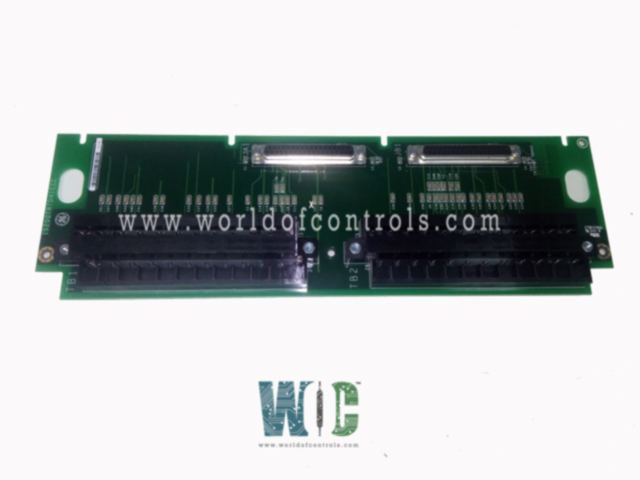
World Of Controls understands the criticality of your requirement and works towards reducing the lead time as much as possible.
IS200TRTDH1CBB - Resistance Temperature Device Terminal Board is available in stock which ships the same day.
IS200TRTDH1CBB - Resistance Temperature Device Terminal Board comes in UNUSED as well as REBUILT condition.
To avail our best deals for IS200TRTDH1CBB - Resistance Temperature Device Terminal Board, contact us and we will get back to you within 24 hours.
SPECIFICATIONS:
Part No: IS200TRTDH1CBB
Manufacturer: General Electric
Product Type: Resistance Temperature Device Terminal Board
Series: Mark VIe
Number of Channels: 8
Maximum lead resistance 15
Operating temperature: 0 to 60 C
Input voltage: 125 V
Total Output: 400 W
Board Size: 6.25 in x 4.25 in
Availability: In Stock
Country of Origin: USA
Manual: GEH-6421L
FUNCTIONAL DESCRIPTION:
IS200TRTDH1CBB is a Resistance Temperature Device Terminal Board manufactured and designed by General Electric as part of the Mark VIe Series used in GE Distributed turbine control systems. The TRTD Resistance Temperature Device (RTD) terminal board supports up to 16 three-wire RTD inputs, which are connected to two barrier-type terminal blocks. These inputs are equipped with noise suppression circuitry to safeguard against surges and high-frequency interference. TRTD communicates with one or more I/O processors that convert the inputs into digital temperature readings, which are then sent to the controller. In the Mark VIe system, the PRTD I/O pack is compatible with both the TRTDH1D and TRTDH2D modules, supporting only simplex configurations. Two PRTD packs are installed in the TRTDH1D and TRTDH2D, allowing for a total of 16 inputs.
INSTALLATION:
The sixteen RTD inputs are connected directly to two terminal blocks on the terminal board. Each block is secured with two screws and features 24 terminals that can accommodate up to #12 AWG wires. A shield terminal strip, connected to the chassis ground, is positioned directly to the left of each terminal block. In a Mark VI system, the TRTDH1B provides redundant RTD inputs by distributing them across three VRTD boards in the R, S, and T racks. These inputs adhere to the same environmental, code, resolution, suppression, and functional standards as the TRTDH1C terminal board, though fast scanning is not supported.
OPERATION:
The terminal board provides a 10 mA DC multiplexed excitation current to each RTD, which can be configured as either grounded or ungrounded. The 16 RTDs can be positioned up to 300 meters (984 feet) away from the turbine control cabinet, with a maximum two-way cable resistance of 15 ohms. The A/D converter on the I/O processor board samples both the signal and excitation current four times per second in normal mode and 25 times per second in fast mode, using a time sample interval that corresponds to the power system frequency.
The software handles the linearization for selecting among 15 RTD types. RTD open and short circuits are detected through out-of-range values. Any RTD that exceeds hardware limits is excluded from the scanning process to prevent interference with other inputs. Once repaired, these channels are automatically re-added within 20 seconds, or manually if needed. All RTD signals feature high-frequency decoupling to the ground at the signal entry. RTD multiplexing on the I/O processor is managed by redundant pacemakers, ensuring that the failure of a single cable or I/O processor does not result in the loss of RTD signals in the control database.
WOC has the largest stock of OEM replacement parts for GE Distributed Turbine Control Systems. We can also repair your faulty boards and supply unused and rebuilt boards backed up with a warranty. Our team of experts is available round the clock to support your OEM needs. Our team of experts at WOC is happy to assist you with any of your automation requirements. For pricing and availability on parts and repairs, kindly contact our team by phone or email.
What type of excitation current does the TRTD provide?
The TRTD terminal board supplies a 10 mA DC multiplexed excitation current to each RTD. This excitation current can be configured as either grounded or ungrounded.
How does the system handle RTD signal sampling?
The A/D converter on the I/O processor board samples each RTD signal and its excitation current. In normal mode, this occurs four times per second, and in fast mode, it occurs 25 times per second. Sampling intervals are related to the power system frequency.
How does the system detect RTD faults like open or short circuits?
RTD open and short circuits are detected through out-of-range values. If an RTD is found to be outside hardware limits, it is excluded from the scanned inputs to prevent interference with other channels.